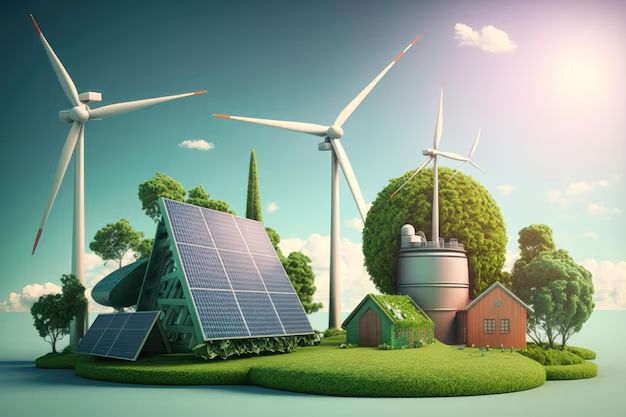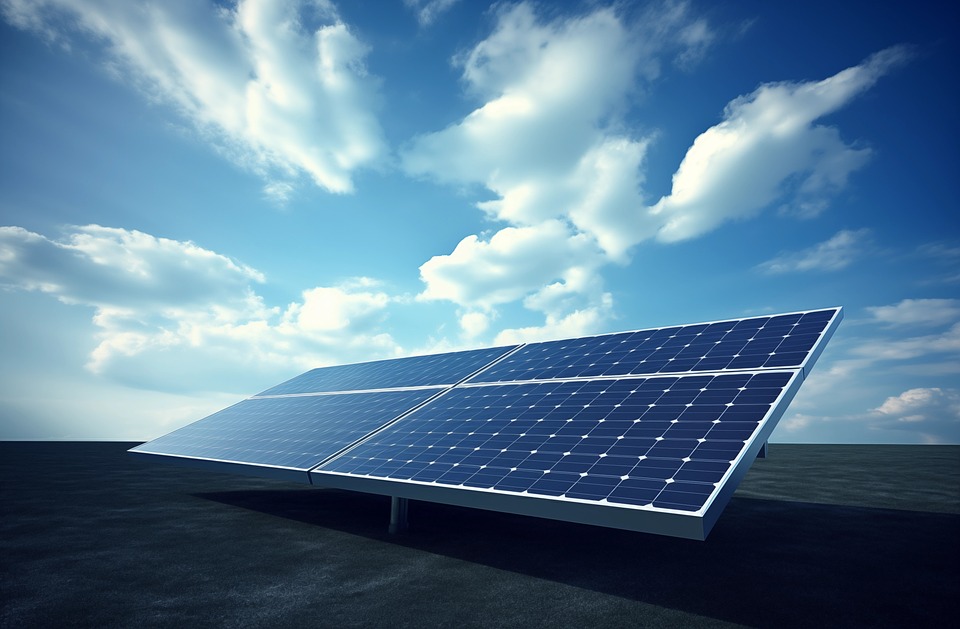Green Technology: The Future of Renewable Energy
Introduction: The Future of Renewable Energy: How Solar and Wind Power Are Leading the Charge

Renewable energy has long been a key solution in the fight against climate change. With fossil fuels depleting and contributing to environmental degradation, the shift to cleaner energy sources is no longer just an option—it’s a necessity. Two of the leading forces in this movement are solar and wind power. As technology advances, these energy sources are becoming more efficient, accessible, and affordable for consumers and industries alike.
Solar Energy: The Power of the Sun

Solar energy is no longer a futuristic concept. With modern photovoltaic (PV) technology, solar panels are more efficient than ever, converting sunlight into electricity at higher rates. In 2024, global solar capacity reached a record high, and projections suggest that solar could become the world’s leading energy source by 2050.
New innovations are making solar energy more accessible. For instance, transparent solar panels can now be installed on windows, effectively turning buildings into vertical power stations. Moreover, solar battery storage systems are becoming more affordable, allowing homes and businesses to store excess energy for use when the sun isn’t shining.
Wind Power: Harnessing the Earth’s Natural Forces
Wind power is another critical player in the renewable energy sector. Onshore and offshore wind turbines are capturing wind energy and converting it into electricity for millions of homes worldwide. Offshore wind farms, in particular, are booming. These farms, located far from land, capture stronger and more consistent wind patterns, making them a highly efficient energy source.
Technological advancements are helping drive down costs. In 2023, the world’s largest wind turbine was built off the coast of China, with a capacity of 18 megawatts—enough to power 20,000 homes annually. With developments like these, wind power is expected to meet 20% of global electricity demand by 2030.
Conclusion: A Renewable Future is Possible
Both solar and wind power are transforming the energy landscape. With ongoing innovations and increasing investments, they are becoming more efficient, cost-effective, and reliable. As governments, businesses, and individuals continue to adopt renewable energy solutions, we are moving closer to a future where clean energy powers the planet.
Eco-Friendly Products: Top 10 Eco-Friendly Products You Need in Your Home
Introduction:
Transitioning to a more sustainable lifestyle doesn’t require major life changes. Often, it’s the small adjustments that make the biggest difference. From reusable household items to energy-efficient devices, here are 10 eco-friendly products that can help you reduce waste, save energy, and contribute to a healthier planet.
Top 10 Eco-Friendly Products –
- Buy From https://sk.digitalman.shop/
- Buy From https://digitalman.shop/
- Bamboo Toothbrushes: A biodegradable alternative to plastic toothbrushes. Buy Link 2 Buy Link 1
- Beeswax Food Wraps: Reusable wraps that replace plastic wrap.
- Stainless Steel Water Bottles: Durable and eco-friendly alternatives to plastic bottles.
- Reusable Produce Bags: Lightweight, eco-friendly bags for grocery shopping.
- Solar-Powered Phone Chargers: Harness the sun’s power to charge your devices.
- Energy-Efficient LED Light Bulbs: Reduce your energy consumption with long-lasting bulbs.
- Compostable Trash Bags: Plant-based, biodegradable alternatives to plastic bags.
- Shampoo Bars: Eco-friendly and plastic-free hair care products.
- Wool Dryer Balls: Reduce drying time and save energy.
- Eco-Friendly Laundry Detergent: Made with natural ingredients and plastic-free packaging.
Conclusion:
Incorporating eco-friendly products into your daily routine is a simple way to reduce your environmental impact. These sustainable swaps can make a significant difference in the long run while promoting a healthier planet for future generations.
Environmental News: Breaking Down the Latest UN Climate Report
Introduction:
The latest report from the United Nations Intergovernmental Panel on Climate Change (IPCC) has just been released, and its findings are both urgent and alarming. The report highlights the accelerating pace of global warming, the increasing frequency of extreme weather events, and the critical need for immediate action. Here’s a breakdown of the key takeaways and what they mean for the planet’s future.
Global Temperature Rise is Surpassing Critical Thresholds
The report confirms that global temperatures have already risen by 1.2°C above pre-industrial levels, edging closer to the dangerous threshold of 1.5°C. Once this threshold is crossed, the likelihood of catastrophic climate events, including heatwaves, droughts, and sea-level rise, increases dramatically. The report warns that without significant reductions in greenhouse gas emissions, we could surpass 1.5°C as early as 2030.
Extreme Weather Events Are Becoming More Frequent and Severe
From record-breaking heatwaves to devastating floods, extreme weather events are becoming more common. The report states that these events are directly linked to human activity and will continue to intensify unless immediate steps are taken to reduce emissions.
The Window for Action is Closing
One of the most sobering findings in the report is the narrowing window for effective action. Scientists emphasize that to avoid the worst impacts of climate change, global emissions must peak by 2025 and decline rapidly thereafter. Delaying action any further will make it nearly impossible to meet international climate goals.
Conclusion: The Time for Action is Now
The UN Climate Report serves as a stark reminder that the world is at a crossroads. Immediate, global action is needed to curb emissions, transition to renewable energy, and build resilience against climate impacts. Governments, businesses, and individuals must all play a role in creating a more sustainable future.
Nature-Related News: The Return of Wildlife
Introduction:
In the face of habitat loss, climate change, and poaching, many species around the world have been pushed to the brink of extinction. However, thanks to global conservation efforts, some of these species are making a remarkable comeback. Here’s a look at a few success stories and what’s being done to ensure their survival.
The California Condor: A Flight Toward Recovery
In the 1980s, the California condor population had dwindled to just 27 individuals, and the species was on the verge of extinction. Today, thanks to captive breeding programs and reintroduction efforts, there are over 500 California condors in the wild and in captivity.
The Iberian Lynx: From Critically Endangered to Vulnerable
Once considered the world’s most endangered cat, the Iberian lynx population has grown from just 94 individuals in 2002 to more than 1,000 today, thanks to intensive breeding and habitat restoration efforts.
The Gray Wolf: A Predator’s Return
Gray wolves were nearly eradicated from the U.S. but have since made a remarkable comeback. Reintroduction programs, like the one in Yellowstone, have helped wolves thrive once again in parts of the country.
Conclusion: The Power of Conservation
These wildlife success stories show that with the right strategies, species can recover. Continued efforts to protect habitats, enforce anti-poaching laws, and mitigate climate change will be critical in ensuring their survival.
